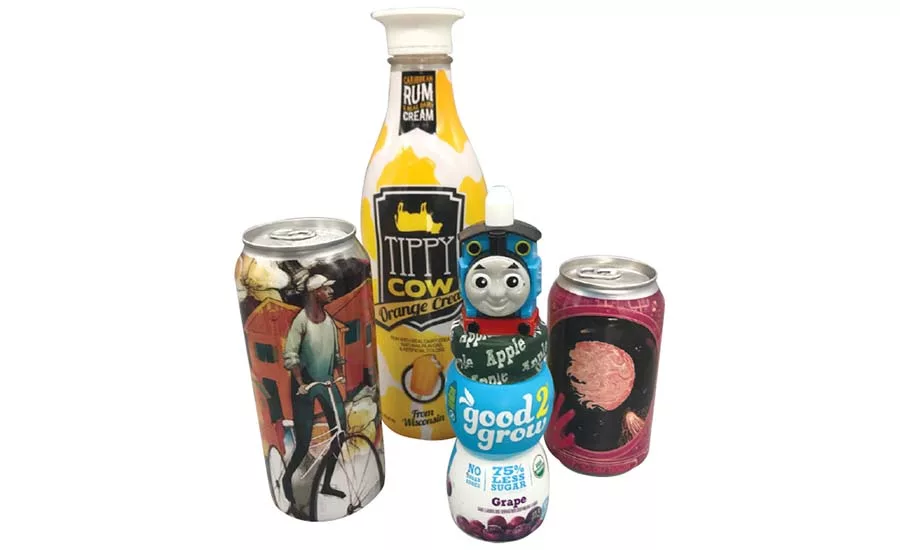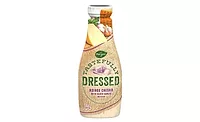Shrink and stretch labels enhance brand messaging, safety
Shrink films protect ingredient efficacy and provide longer shelf life

A sleeve label is applied to an aluminum can or container in multiple ways, from covering just the shoulders or the cap of a container to full-body, 360-degree coverage. The use of shrink labels on Collective Arts Brewing’s beer cans, Tippy Cow’s rum and cream, and Good2Grow’s juice beverage are examples of various sleeve labels produced by PDC International. (1-pint can photo by Mary Hassdyk and 12-ounce can by Barbara Ann Gomez for Collective Arts Brewing. Image courtesy of PDC International)
A staple for creative pre-teens, Shrinky Dinks are pre-printed clear sheets of polystyrene that are colored, then baked-to-shrink in an oven before being transformed into creative jewelry, ornaments and figurines. Utilizing a similar functional concept, shrink and stretch labels are “transforming” the packaging materials market as beverage-makers look for safe, sustainable and colorful wraparound labeling solutions that help products pop on store shelves.
Experts note that various trends are facilitating an increase in usage of stretch and shrink labels, including proliferation of functional beverages, sugar reductions, natural ingredients as well as ingredient transparency.
Leslie Kozar, senior marketing manager for Rapid-Roll at Mentor, Ohio-based Avery Dennison Label and Packaging Materials, suggests that packaging choices need to be considered upfront, particularly because functional beverages such as juices, waters and smoothies that supplement a meal or replace a meal altogether are the beverage industry’s new normal.
“There is now a much wider range of functional benefits being offered than previously available,” Kozar says. “New ingredients, infusions and additives are proliferating the space, and with more active and functional ingredients, packaging choices need to be considered in regard to the potential implications or compromise of ingredient efficacy.
“Consumers are looking for products with less sugar and preservatives,” she continues. “Brand owners and beverage manufacturers need their products to last longer without these additives, so they face the challenge of barrier properties. Full-body sleeves continue to evolve to meet these needs.”
For example, drink sleeves with light barrier features can help protect light-sensitive ingredients in products.
Which ingredients are used, from where they are sourced — the product journey — and the clarity of the package and label also should play a pivotal role in which label materials and designs are chosen to represent the brand, Kozar adds.
Aesthetic appeal
Gwen Chapdelaine, marketing director for Fort Dearborn Co., affirms that the continued development of innovative beverage products, the ability to grab consumer attention on shelf and the opportunity to utilize the functional benefits of sleeves are driving continued innovation for stretch and shrink labels.
“We’ve also seen the increased use of shrink sleeves on cans for the beverage industry,” Chapdelaine says. “Sleeves are an economical alternative to pre-printed cans and provide eye-catching, 360-degree bright opaque graphics.”
In addition to cans, the Elk Grove, Ill.-based company is seeing more multipacks and on-packs featuring shrink sleeves because of the advantages they provide versus other label formats. In addition to the colorful, impactful 360-degree coverage, sleeves allow beverage-makers to utilize a single colorless container, and differentiate various products and lines with complete coverage of complex-shaped containers; an ability to incorporate tamper evidence on packs; and more space to provide on-pack promotional and merchandising opportunities, the company says.
Chapdelaine notes that shrink sleeves also facilitate product protection and contribute to a longer shelf life. “This feature of shrink sleeves allows for the incorporation of light barrier features within the label, thus increasing shelf life of light-sensitive products such as vitamin-fortified waters and dairy products,” she explains.
Yet, Michael Johnston, marketing coordinator at PDC International, Norwalk, Conn., notes that unique bottle shapes can present some industry benefits and challenges. “Shrink sleeves excel at covering bottles with complex curves, while pressure-sensitive labels require straight walls on which they adhere,” he explains. “Shrink sleeves can incorporate tamper evidence adding to customer confidence.”
Speed and versatility
The shrink and stretch sleeve labels market continues to make waves in the food and beverage industries. In fact, the market was valued at $10.3 billion in 2019 and is expected to reach $15.5 billion by 2025, at a compound annual growth rate (CAGR) of 6.5 percent over the forecast period of 2020-2025, according to Hyderabad, India-based Modor Intelligence’s report titled “Shrink and Stretch Sleeve Labels Market – Growth, Trends and Forecast (2020-2025).”
Although sleeve labels provide colorful wraparounds of multi-sized products, stretch labels come with zero adhesiveness or heat and rely only on their elasticity to hold the shape of the container, the market research firm states. In production, however, the application rate for stretch sleeve labels is slower, typically less than 150 containers a minute, while shrink sleeve labels are generally packed at higher throughput rates of as many as 800 containers a minute.
To meet customer expectations, equipment manufacturers are constructing better end-user equipment. For instance, PDC has seen an upsurge in smaller-sized microbreweries in need of new technology. “With this in mind, we created a compact, energy-efficient shrink tunnel with [an] integrated steam boiler, ideal for microbreweries and those just getting into the business,” Johnston says.
Sophisticated shrink sleeves
Experts note that shrink sleeves also have gotten more sophisticated while offering enhanced substrates, varnishes and graphics.
“What were considered ‘fancy’ or expensive labels are now commonplace in the market,” says Justin Slarks, director of marketing at Sleeve Seal, Little Rock, Ark. “Printing costs and films costs continue to be more affordable, so more manufacturers are embracing shrink labels.”
The company offers specialty printing to create unique, marketable brand images and offers 10-color gravure printing and more matte finishes, metallic and pantone matching system colors for a developed, high-end look.
The Avery Dennison Rapid-Roll shrink sleeve portfolio includes a broad range of options with shrink properties and printability for various applications, Kozar says. “We also offer Eklipse shrink film with light-blocking properties to help brands achieve longer shelf life while providing excellent product protection,” she says. “Digital printing has continued to evolve, especially with new advances in UV inkjet technology, which has made it more adoptable.”
Fort Dearborn Co. offers a flexible printing solution including digital for prototypes, regional promotions, personalization and small volumes, flexographic for mid-size volumes, and rotogravure for longer production runs, Chapdelaine says. “Our material options include PVC, PETG (clear and white), OPS and PLA as well as recyclable and floatable shrink films designed to improve the recyclability of PET beverage containers,” she says. “With recyclable sleeves, the inks wash off the label during recycling, allowing the film to be recycled with the container, making them a win for brands and the environment.”
Sustainability with sleeves
Packaging materials and other labeling trends such as reducing unit cost, thinner label stock, the reduction of material waste, greater use of sustainable materials, anti-counterfeiting and tamper-evident measures continue to drive innovation and growth in the market, experts say.
“Thinning label stock is a hot topic, but few labeler manufacturers are able to apply thin film at speed,” Sleeve Seal’s Slarks says. “We have developed a labeling system that delivers very high efficiencies to reduce waste and drive systems that are able to apply materials as thin as 25 micron, but I think we are one of the exceptions.”
PDC’s Johnston also points to cost-reduction through downgauging of materials and employing different print methods. Products that use shrink sleeves also further recycling, he adds.
“The fact that shrink sleeves do not use adhesives to anchor themselves to the bottles allows less complications in the recycling separation process,” Johnston explains. “In the future, we’ll see further reduction of material waste and sustainability through new innovations in recycling processes and the use of more biodegradable processes.
“… Shrink sleeves also help with anti-counterfeiting as the shrink sleeve can now carry invisible inks, transferring inks and holograms, which provide authentication of the product,” he continues. “Innovation is occurring every day and shrink sleeves are on the leading edge of that innovation.” BI
Looking for a reprint of this article?
From high-res PDFs to custom plaques, order your copy today!






